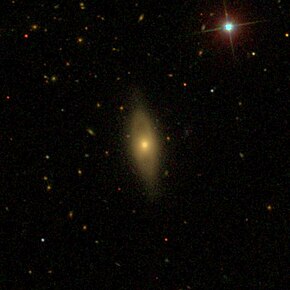Loading AI tools
Galaxy in the constellation Pisces From Wikipedia, the free encyclopedia
NGC 525, also occasionally referred to as PGC 5232 or UGC 972, is a lenticular galaxy located approximately 95.6 million light-years from the Solar System[4] in the constellation Pisces.[2] It was discovered on 25 September 1862 by astronomer Heinrich d'Arrest.[5]
| NGC 525 | |
|---|---|
 NGC 525 as seen on SDSS | |
| Observation data (J2000[1] epoch) | |
| Constellation | Pisces[2] |
| Right ascension | 01h 24m 52.9s[3] |
| Declination | +09° 42′ 12″[3] |
| Redshift | 0.007158 ± 0.000167[1] |
| Heliocentric radial velocity | (2138 ± 50) km/s[1] |
| Distance | 95.6 Mly[4] |
| Apparent magnitude (V) | 13.3[2] |
| Apparent magnitude (B) | 14.3[2] |
| Characteristics | |
| Type | S0[2] |
| Apparent size (V) | 1.5' × 0.7'[2] |
| Other designations | |
| PGC 5232, UGC 972, MGC +01-04-054, 2MASS J01245290+09421164[1][5] | |
D'Arrest discovered NGC 525 using his 11-inch refractor telescope at Copenhagen. He located the galaxy's position with a total of two observations. As he also noted the mag 11-12 star just 2' northwest, his position is fairly accurate.[6] The galaxy was later catalogued by John Louis Emil Dreyer in the New General Catalogue, where it was described as "very faint, very small, 11th or 12th magnitude star 5 seconds of time to west".[5]
The galaxy appears very dim in the sky as it only has an apparent visual magnitude of 13.3 and thus can only be observed with telescopes. It can be classified as type S0 using the Hubble Sequence.[2] The object's distance of roughly 95.6 million light-years from the Solar System can be estimated using its redshift and Hubble's law.[4]
Seamless Wikipedia browsing. On steroids.
Every time you click a link to Wikipedia, Wiktionary or Wikiquote in your browser's search results, it will show the modern Wikiwand interface.
Wikiwand extension is a five stars, simple, with minimum permission required to keep your browsing private, safe and transparent.